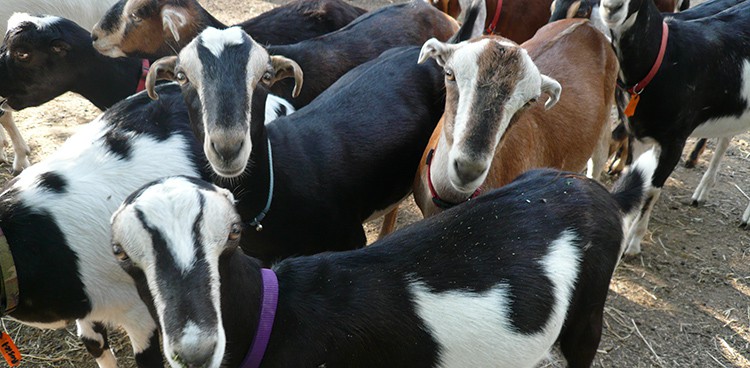
Origin
LaMancha goats are easy to recognize, what with those cute little ears, but the exact origin of the breed is not easily traceable. The La Mancha region of south-central Spain seems the most likely source of what we know today as the American LaMancha. Although shepherds in this region had no official name for the tiny-eared goats that frequently appeared in their stock, they did recognize them as being different, referring to them as monas (little monkeys) or monadas (cuties). The lack of an external ear is actually a common genetic mutation that has been noted in goats the world over, including in ancient Persia and more recently in Ethiopia, Egypt, and Turkey.
History
Chroniclers of the breed speculate that the LaMancha precursors arrived in California with Spanish missionaries in the early days of European exploration of the Americas. Another story indicating their Spanish origin offers an explanation of the source of the name LaMancha. As the tale is told, a crate containing several small, sturdy goats arrived in Paris in the early 1900s with part of the labeled obscured, the only readable words being “LaMancha, Cordoba, Spain.” The story is not easily verified, nor does it explain why the little travelers would have been in Paris. A firmer record of LaManchas as a distinct goat variety begins in the western United States in the 1920s and 1930s. Two early LaMancha advocates, Phoebe Wilhelm and Eula Fay Frey, crossed LaMancha-type goats with other dairy breeds to increase the qualities that make them good dairying animals. Frey advocated for LaManchas to be accepted to the American Dairy Goat Association registry and succeeded in 1958, with her buck Ernie becoming the first registered LaMancha goat. Thus was the first true American goat breed born.
Appearence
LaManchas are prized for their milk and their adaptability as well as for their most unique feature (or lack thereof)—their ears. LaMancha ears are divided into two types, gopher and elf. Gopher ears have a maximum length of an inch and are almost flat with circular folds, no stiff cartilage, and a tiny flap. Elf ears are similar but are up to two inches in length, with some cartilage.
Other notable physical characteristics of the breed include a straight nose and a short, glossy coat that comes in a wide variety of colors and patterns. A LaMancha goat’s horns are almost always disbudded prior to two weeks of age, but if left to grow, they naturally curl backward like smaller versions of those found on bighorn sheep.
Temperament
When it comes to personality, LaManchas have it in spades. “La Manchas are extremely intelligent goats—they have a very crafty personality,” says Leslie Cooperband, owner of Prairie Fruits Farm and Creamery, a producer of farmstead goat’s milk cheeses in Illinois. “They are usually the first ones to figure out when someone has left a gate unlocked to make their escape from the barn to the orchard or to the stash of grain.” While Cooperband notes that they aren’t quite as social as some other breeds like Nubians, LaManchas are a docile, affectionate, quiet bunch.
“LaMancha popularity and numbers have increased enormously in the last 10 years, especially in the commercial dairy setting,” adds Barbara Backus, a longtime LaMancha breeder and the owner of Quixote LaManchas and Goat’s Leap Cheese in Saint Helena, California.
Milk & Cheese
LaManchas are dependable producers, and their milk has a high butterfat content—usually between 3 and 4 percent—with a protein content right around 3 percent. Cooperband notes that the milk from her LaManchas is just as sweet as the milk from her Nubian goats, thanks to a similar lactose content. And while Backus notes that Nubian milk is the highest in solids (making it very desirable for cheesemaking), the LaMancha boasts a longer, more consistent lactation period than the average Nubian.





2 thoughts on “Farm Animal: LaMancha Goats”